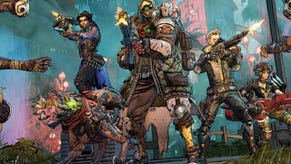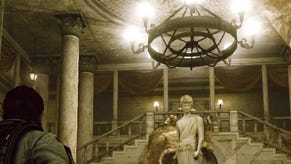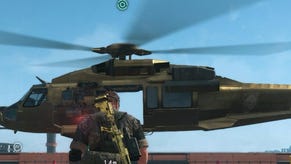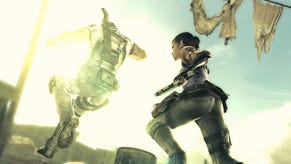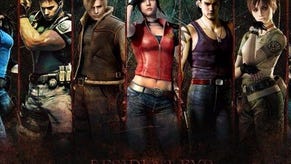Resident Evil 6 Preview: True Horror Returns
Capcom expands the world of survival horror.
Resident Evil's been going strong for so long that it has become all things to all people: an exercise in suspense and horror for some, or a lesson in video game action at its very best for others. Maybe for you it's a schlocky soap opera set in the world of the undead or - God forbid - a glut of increasingly indecipherable third-tier movies.
For a series spread so wide and often so thin it's not surprising that Resident Evil's dabbled with mediocrity in the past - witness the ill-conceived Outbreak games, or the miserably executed Operation Raccoon City. Even its highs have fallen some way short of what once was, the enjoyable brace of 3DS games showing a series that's now become torn between action and horror.
For two and a half years, a 600-strong team at Capcom has been toiling on a new Resident Evil that's working to bridge that divide. It's a horror game with action set-pieces, a drama in which an undead President is played with the straightest of faces, and a game with tension as well as a warehouse of explosives to play with. It is, in other words, all things to all people - but what's most impressive is how Capcom's all-encompassing take on its long-running series pushes it back towards the brilliance of its glory years.
With Resident Evil's creator Shinji Mikami long gone and the director of Resident Evil 5, Jun Takeuchi, taking a step back, it's a fresher, more youthful team that's heading up Resident Evil 6 - and one that's injecting a sense of vibrancy to the series that's been missing since 4.
"I wanted to change the way we do things," says director Eiichiro Sasaki, a man whose credits include exuberant adventure game Zack & Wiki and whose prior experience with Resident Evil comes largely through the Outbreak games.
"Normally the production on our games is pretty top-down, like a waterfall if you will. Everything comes from the top, it moves down and everyone works on their piece as it hits them. But we wanted to have more freedom in terms of how we went about our approach. So we had different core members come up with the different elements of the game, and those would radiate out to the different teams that were involved."
The result is a sense of variety that, while not exactly new to the series, has been lost of late. It's explicit, as well: Resident Evil 6 features three playable characters, with three separate tales that will interweave with one another, each of them starting at different places across the globe before ending up in Resident Evil 6's key locale, China. And each tale will be playable from the outset, promising the kind of intertwined story delivered in Revelations, but writ large across a home console experience.
"Leon Kennedy was going to be the main character at first," executive producer Hiroyuki Kobayashi reveals. "But Sasaki-san approached me and asked if Chris Redfield could be put in as well. I was against this idea at first - we just had him as the main character in Resident Evil 5, and I didn't think it would be a draw for people if it was just the same character that we had before. But he showed me the concept art of Chris and Leon aiming their weapons at each other - and he said he wanted to do this in the game. I thought that was interesting, it was something different and in a direction that might shock fans of the series."
"After Resident Evil 5 came out Takeuchi came to me and asked me to do Resident Evil 6. But I said no, no, no - I'm not doing it. The reason I didn't want to do it is because it's so damn hard to make these games. He said well, you can have Hirabayashi and you can have Sasaki as the director, so I thought if you can give me that maybe I can do it. Because we've got all three of us on the game so that made it possible."
Hiroyuki Kobayashi, executive producer
Leon's tale starts out in Tall Oaks, a fictional spin on the kind of leafy Americana that framed his debut in Resident Evil 2, while Chris' story starts in flashback to a snowy backdrop, where the seeds of his own fate are sown. Joining the pair is a character new to Resident Evil's dense universe, but born tangled into its web. Jake Muller is the son of super-villain Albert Wesker, his story starting in the Eastern European state of Edonia (don't bother looking it up - it's another of Capcom's wonderful fabrications).
Each comes with a partner, suggesting that Capcom hasn't yet given up on the co-op vision laid out by Resident Evil 5. Leon's shadowed by government agent Helena Harper, Jake gets to pair with Sherry Birkin while Chris is accompanied by Piers Nevans, a BSAA operative who, we're told, is handy with a sniper rifle. As a feature, it looks to have improved somewhat since its last outing - drop-in/drop-out play joins the local and online options, and a brief glimpse of it in action reveals it's not as obtrusive as it once was.
Three characters mean three different stories, but it means something potentially more exciting than that. It allows for three different perspectives on the series staples, three different play-styles and, judging from what's been shown so far, three very different games.
For Chris, it's an action title not far removed from his last starring role. For Jake, it's an experience with a more adventurous slant, his escape from the authorities leading to action that's perhaps more in tune with Uncharted than Resident Evil. And for the traditionalists, Leon offers a take that's slower, more explicit in its horror.
Three potentially disparate experiences, but Capcom intends to thread them all together. "What we're trying to do with Leon, for example, is a real recreation of gothic horror style," Sasaki says. "Some people would say we're trying to recreate Resident Evil 1, but that wouldn't be accurate - Resident Evil had its own sense of horror. This feels more like the horror you're used to in the original, but we're taking it in a new direction. We're making sure there are horror elements in all the character's stories."
"Horror's not monolithic," Sasaki continues. "There are different types of horror in different media. So there are different types of horror in Resident Evil 6 - Leon will have that gothic horror, while with Chris there will be horror elements born out of the different stages of his story - different things will show up that you'll have to fight against."
Part of that horror comes from a new strand of enemies born from Resident Evil 6's new plague (some series offer bigger, better guns - Resident Evil's unique in that it offers bigger, better diseases). The C-virus entombs those it infects in a chrysalide, and what pops out comes as a surprise - think of it as a particularly nasty brand of Kinder egg.
The enemies that emerge are know as the J'avo, and they're the centrepiece of Resident Evil 6: the headline additions that promise to push the new combat system to its limits. When struck with a bullet, the stricken limb regenerates and mutates into a new and often unpredictable form, the idea being that they're a constantly evolving enemy that require a constantly evolving strategy if they're to be conquered.
"With Resident Evil 5, what you saw was pretty much a straightforward game from start to finish. There wasn't much variety in terms of where you were and what you were doing - we wanted to bring that back a little. Each part of the game stands out on its own, and you feel like you're experiencing something different depending on where you are in the game. Basically, the guiding theme was of spatial orientation - that we'd focus on certain areas and give the best performance from each scene, each backdrop."
Yoshiaki Hirabayashi, producer
They're largely absent from this early look, however, ensuring that it's the return of a more classical enemy that's going to generate the most interest. Having taken an absence of leave since Los Ganados took their place in Resident Evil 4, the zombies return. They've evolved somewhat since their last starring role, having graduated from the Romero school of shuffling and taken up classes with Danny Boyle's more athletic vision of the undead. This lot can lunge quickly for you and, like Los Ganados, can wield weapons.
A new, more modern control system presents the tools to deal with the new threat. The ability to move and shoot may be bread and butter for other third-person action games, but for Resident Evil it's a sizeable step forward - and it's joined by a handful of other introductions. Enemies can knock you to the ground, from where you'll be able to scramble around on your back and fire off a handful of desperate shots before getting back to your feet. When you're prone, enemies can lunge towards the player, sparking a small, rhythmic QTE.
All of this is shown in action throughout an extended play-through of an early section in Leon's tale, taking place in Tall Oaks and the bluntly named Ivy University. It's a return to the kind of overplayed Americana that could only have come from Japan and the aesthetic that framed Resident Evil 2. But, of course, it's never looked quite so handsome.
MT Framework 2.0 provides the fireworks, as well as some exquisite lighting. The University is a dense and believable backdrop, brought alive with flashes of thick blue lightning that streams through tall windows, as well as bursts of incredible detail. Leon passes through a large dining hall that bears the marks of a recent celebration - countless balloons bump up against the high ceiling, while shreds of brightly coloured paper dangle down. Leon feels a part of his surroundings too, occasionally leaning against a door frame or brushing aside a discarded chair - we've come a long way from the pre-rendered backdrops of old.
As visually strong as Resident Evil 6 is, it's Capcom's scenario writers that provide the real sense of canny drama, tightly strung - as ever - somewhere between farce and terror. It starts promisingly enough with Leon landing a headshot on a freshly infected US President, and tumbles pleasantly further into chaos from there.
Leon and Helena meet up with a man in pursuit of his daughter, who then proceeds to lead the pair by flashlight through the dark, labyrinthine hallways of the campus. There follows a slow, tense trawl shot through with Capcom's typical beats - while not a single gunshot is fired. The tension of what lies beyond an unopened door is constantly played upon, and all the while our guide complains of fever and itches.
With father and daughter reunited, the group moves into a small elevator - never a good idea when there are infected in tow - and on cue the lights cut out once the doors draw close. Sloppy chewing noises break through the dark, and once the lights come up the daughter's revealed to be feasting on her father. What follows is a close, claustrophobic action sequence as Leon fights her off.
It's one small example of Resident Evil 6's desire to smear the line between cut-scene and action proper. "We put together a whole team that's dedicated to these mini-scenes in the game," producer Yoshiaki Hirabayashi tells us later. "So instead of just cut-scenes and then gameplay, there's all these little dramatic tales that unfold in the game itself that aren't part of a cut-scene but are just as dramatic, and just as intense."
When the action goes loud it proves to be just as intense. Having escaped the elevator, Leon and partner find themselves facing a horde of undead. Superficially, the action's akin to Resident Evil 4 - and the return of Leon's lank locks likely helps make that association - but with a handful of welcome flourishes. Leon's handier in close combat, able to disarm opponents and swiftly use their weapons against them. At one point, when a headshot merely chews off a chunk on an oncoming zombie's scalp, Leon finishes off the job with a knife swiftly delivered to the underside of the chin.
It's palm-slicking suspense, followed - in the flicker of a broken light - by breathless action: a seamless blend of the two separate paths that Resident Evil has walked to date. A new emphasis on action has been complemented by an underlining of the traditional horror elements. Resident Evil 6 has, in short, got the promise to bring together the very best of the series to date.



